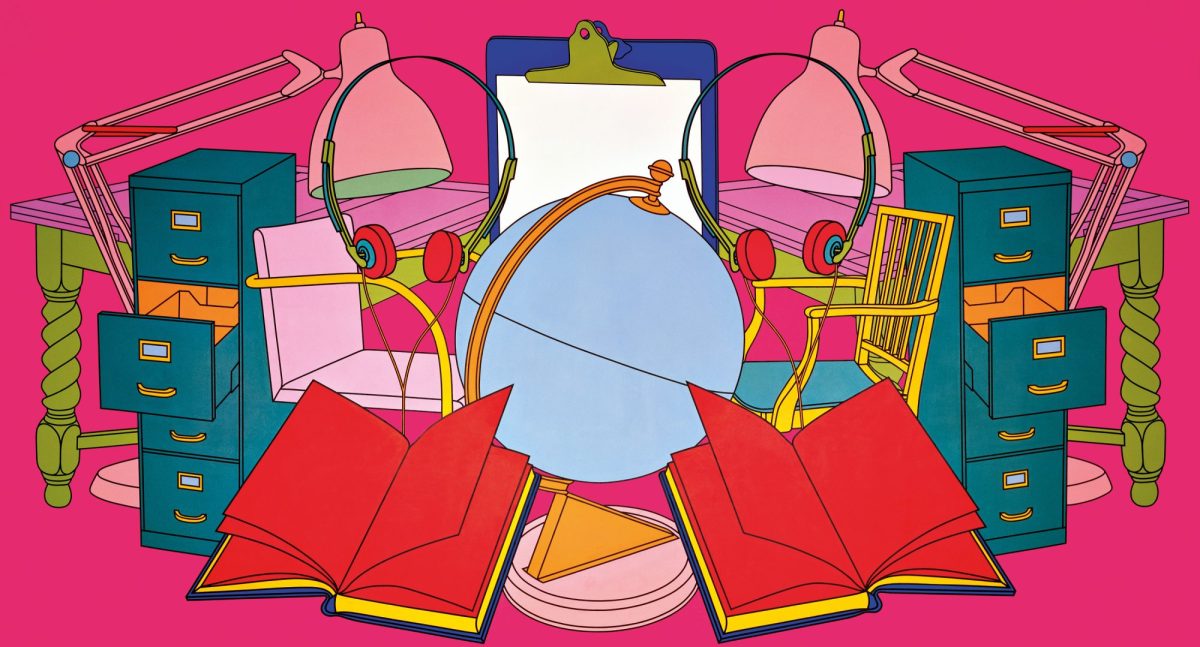This impressive and expansive survey of work by the British artist Michael Craig-Martin begins before you even enter the Royal Academy of Arts building. Colourful metal sculptures of everyday objects greet you as you cross the courtyard from Piccadilly to Burlington House. Looking temptingly like climbing frames from a children’s playground, these are shapes to be admired and not embraced, and reflect some of the large-scale site-specific installations for which he’s become known in recent years.
Inside the gallery, the exhibition is a riot of colour with the walls painted in brilliant neon hues to complement the artist’s vivid palette. He is nothing if not a bold colourist and this gives the exhibition its passion and excitement. Can the pink ever be hot enough or the blue ever deep enough for Craig-Martin?
Now 83, Craig-Martin has been part of the art establishment for decades with a career built on his early conceptual work. His seminal 1973 work, An Oak Tree, rightly takes pride of place in the first room alongside two other famous conceptual works On the Table and On the Shelf. These are now iconic works, instantly recognisable in the canon of conceptual art and worthy of a place in any art museum. Interestingly, An Oak Tree is listed as an artist’s proof, on loan from the National Gallery of Australia. It is accompanied by a lengthy text on the wall in which the artist explains how the glass of water became an oak tree.
This room clearly demonstrates Craig-Martin’s significant place in the history of contemporary art and his relationship to artists like Andy Warhol, Marcel Duchamp and Joseph Kosuth. And like Duchamp and others, Craig-Martin soon adopted the language of ready-mades and everyday objects in his artworks.
These found their way into big, bold works, full of strong lines, simplified shapes and bright colours. Much of the exhibition features these striking works, hung against the newly-painted colourful walls. Mobile phones, light bulbs, umbrellas and musical instruments all have their moment in the spotlight – these everyday objects painted in stark graphic style. Many of these larger-than-life works are painted on aluminium panels, rather than the traditional art canvas, to create a flatter, stronger image.
These later works talk to the inevitable intersection between technology and digital culture, but somehow feel superficial. Craig-Martin says he’s interested in “eliminating all traces of the artist’s hand” in his work. Looking at this exhibition, it’s fair to say he has largely succeeded, but is that a good thing? This is just one of the philosophical questions to muse on as you stroll through this vast exhibition.
As you move through the various rooms, each highlighting a different stage or decade of his long career, it seems the works become more superficial and less engaging, lacking somewhat in both emotional and intellectual intensity. One or two pieces do stand out. Tucked away in a corner is a striking aqua-coloured self-portrait from 2007, while 1999’s Common History: Conference, painted as a commission for a conference in London, is striking in its size and energy. Then there is Modern Dance, a wall-sized work from 1981, created entirely from black tape. It really is fascinating to see the changes in his style and output over such a long career and there really is so much here to see and think about. With over 120 works on display this is not an exhibition to view in a hurry!
The last room in the exhibition is an immersive video installation where all these key images from his work flash by you in hyper-real colours. This is a 2024 vector animation called Cosmos – it’s fun for a few minutes, but then it just feels like so much visual noise, here for a moment and then gone.
Alongside his art practice, for a long time Craig-Martin was a professor at the prestigious Goldsmiths College in London, where he taught many of the famous generation of ‘Young British Artists’ including Damien Hirst and Sarah Lucas. He was admitted as an Academician at the Royal Academy in 2006 and promoted to Senior Academician in 2015, so it is appropriate that it should now host this major survey of his work that highlights his important contribution to conceptual art and contemporary visual culture.
Read: Exhibition review: Van Gogh: Poets and Lovers, National Gallery, London
Established in 1768, the Royal Academy’s first President Sir Joshua Reynolds famously said, “An Academy in which the Polite Arts may be regularly cultivated is at last among us by Royal Munificence.” Craig-Martin’s work shown here is most definitely polite. And, as you exit towards the gift shop, be sure to look up and appreciate the magnificence of the architecture in the wonderful Wohl Central Hall.
The works of Michael Craig-Martin will be exhibited at the Royal Academy until 10 December 2024. Tickets: £22. Closed Mondays.




